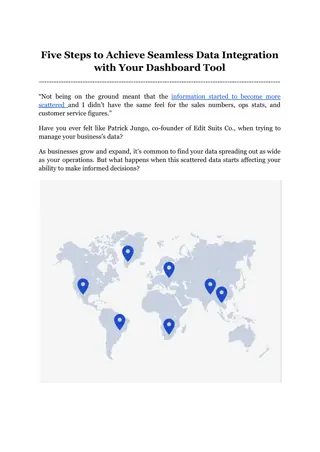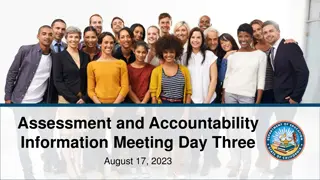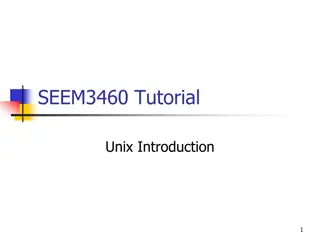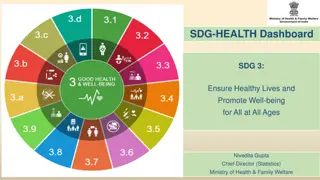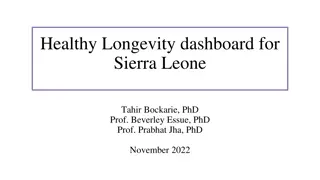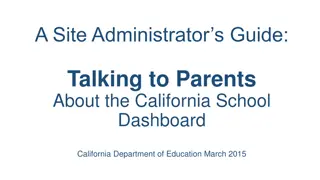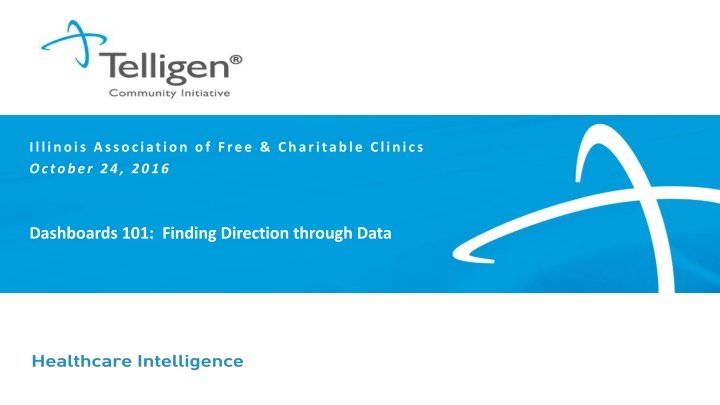
Dashboards: Empowering Organizations with Data Insights
Explore how dashboards can revolutionize decision-making in organizations, enabling efficient communication and strategic planning. Learn the foundational concepts, benefits, and real-world examples of dashboard implementation for enhanced impact.
Download Presentation

Please find below an Image/Link to download the presentation.
The content on the website is provided AS IS for your information and personal use only. It may not be sold, licensed, or shared on other websites without obtaining consent from the author. If you encounter any issues during the download, it is possible that the publisher has removed the file from their server.
You are allowed to download the files provided on this website for personal or commercial use, subject to the condition that they are used lawfully. All files are the property of their respective owners.
The content on the website is provided AS IS for your information and personal use only. It may not be sold, licensed, or shared on other websites without obtaining consent from the author.
E N D
Presentation Transcript
Illinois Association of Free & Charitable Clinics October 24, 2016 Dashboards 101: Finding Direction through Data
Agenda Introductions: Melissa Maguire, Vice President of Mission Fulfillment, The Night Ministry Aleta Rupert, Director of Business Development & Strategy, CommunityHealth Matt McGarvey, Executive Director, Telligen Community Initiative Dashboard Overview: Session objective Uses for an effective dashboard? Why do a dashboard what drove each of our organizations to attempt to create a meaningful dashboard? Organizational Specific Examples: Each of us will offer examples and a brief discussion of our approach to an at-a-glance tool with the following goal: Helping you identify what might work for you/demystifying dashboards and getting started. Tools that you can either use yourself or customize to your needs to begin your own dashboarding journey. Questions / Discussion 2
Session Objective Dashboards 101: Finding Direction through Data: Imagine having an at-a-glance tool that uses the data you already collect to determine priorities, improve decision-making and effectively communicate with your volunteers, staff, board, community and donors. Dashboards have been used in other sectors with great success; come learn how two clinics and one foundation use dashboards to inform staff and engage boards to promote a culture of learning and improving. By the end of the session, participants will know what a dashboard is and how it works, understand how to begin creating dashboards for their own clinics, and leave with examples of actual clinic dashboards. 3
Dashboarding 101 Foundational Concepts Dashboard What is it? A visual representation that gives decision-makers a quick and easy way to view their organization s progress in meeting chosen indicators in real-time. If done well, dashboards are an invaluable tool for cutting through data clutter and getting down to the most important impact metrics for our organization (don t try to boil the ocean). Strive to build an at-a-glance tool that captures the most key indicators that can inform both immediate actions to take, as well as future decisions versus your organizational strategic plan. Focus on the key information it zones in on your nonprofits key metrics and measures and visually represents them in a single view putting all the relevant data in one place. 4
What benefits do dashboards provide? 1. They enable better, smarter, faster decisions. First figure out your most key pieces of data. By integrating these key data points in an easy-to-understand way, the conversation can be elevated beyond the parsing of details. Details still exist but it moves to a supporting, rather than leading role. Information overload is avoided. 2. They get everyone on the same page. Exactly and literally. By having consensus of everyone looking at the same metrics and key impact indicators, your organization can work together one a set of common goals (as opposed to being led in different directions by different sets of numbers). 3. They create buy-in on what success looks like. This allows all organizational stakeholders to objectively decide on what s important. If you don t have this at the start, the exercise of building a dashboard and what should inhabit it will quickly call the question. Strive to build a tool that creates less of an opportunity to choose numbers that tell a story in the eye of the beholder rather, the team is forced to listen to, and deal with, the story told by the data. The dashboard is just a means to a larger end. 4. They track progress and show improvement. By measuring the same things, consistently over time, your efforts (sometimes painful) can be the embodiment of the dashboarding journey. 5
Two Key Challenges of Dashboards? 1. Choosing what metrics to track. Determine the most important and impactful metrics of your organization and its success work backwards from there. After determining key measures of success, figure out the underlying metrics those factors that actually drive the key measures. These driving / predictive, underlying metrics are critical to if you achieve the over-arching organizational objectives (or not). At the start and if you simply don t know, make your best judgments regarding these drivers and begin to build the ability to track those thing you think that contribute most to your overall organizational success. 2. Building your dashboard. Ideal dashboards automatically and securely connects to your data sources in real-time, so as to continuously update in real- time. Strive to build that kind of rigor and discipline. The alternative is for employees to manually enter data to the dashboard. Exponentially increases the chances for error, incomplete, wrong or old data. Recognize this is an iterative process that should be a living document. It might not start out in this ideal state, but always be building towards automation and data purity/transparency. 6
Organization-Specific Dashboard Examples, Journey & War Stories Organizational leaders and example dashboard approaches. Melissa Maguire, Vice President of Mission Fulfillment, The Night Ministry Aleta Rupert, Director of Business Development & Strategy, CommunityHealth Matt McGarvey, Executive Director, Telligen Community Initiative Desired Take-Aways: There is no one right or perfect way to approach dashboarding: Cherry-pick what makes sense to you and help lead your organization to even agreeing to get started on this approach. Motivation / Why: Listen to each person and organizational motivation for getting started on the development of a dashboard. Actionable Tools: We want to provide you with examples and even tools that might help you begin or refine this within your own organization. Conference attendance is always a good thing to network, recharge and inspire. We hope to go a step further and give you examples and even desk-reference-like tools to make this less daunting when you get back to the office. Get Started; Don t be Afraid to Fail 7



